#he is supposed to be the antithesis of his father in a cultural context and even sometimes mythical
Explore tagged Tumblr posts
Text


these tags by @aroaceleovaldez deserve their spotlight because i could not have said it better myself
at some point rick decided that the big bad, the big evil tyrant, was zeus and all of the gods were also victims and powerless to him even though that was never the case in pjo and sadly this mid-hoo/toa caricature-ish characterisation of zeus and the gods stains everything rick comes out with now
#pjo zeus>>>>>>hoo and toa zeus (AND ESPECIALLY COTG ZEUS DEAR GODS WHAT HAVE THEY DONE TO YOU ZEUS)#i am the no 1 hater of the zeus villain trope and i love how in the original pjo he's sometimes rash and paranoid#but ultimately a serious authority figure and maybe not the best dad but someone who is trying#people need to forget the myths for a fucking minute bc THOSE ARE JUST STORIES WRITTEN BY HUMANS A LOT OF THE TIMES FOR ENTERTAINMENT#AND TO EXPLAIN NATURAL PHENOMENONS#(e.g. the abduction of persephone explaining the seasons)#if you actually look at the cultural context the gods were so revered and beloved by their people#and guess what?? most of all zeus#the god who is constantly referred to as a father figure to literally everyone and the god of being polite to guests (xenia)#i will never forgive rick for the damage he has done to the perception of zeus and greek mythology in general#anyway that's my own rant carry on#rr crit#actually wait i'm not done#making zeus an autocratic figure not only disrespects the concept of polytheism but also defeats the point of the olympian council#need i remind everyone that zeus specifically split the domains between the gods and had a council bc he learned from kronos' mistakes#of controlling everything??#he is supposed to be the antithesis of his father in a cultural context and even sometimes mythical#and when he made the same mistakes as his father he paid for it (with the attempted rebellion) and learned better!!
263 notes
·
View notes
Text
Anime Ramble: Puella Magi Madoka Magica
Magical Girl anime have this tendency to provoke a binary reaction. Either you see Magical Girls on the promo material and want to watch the show, or else you don’t. So, I’d like to preface this bout of gushing-about-a-show-that-I-watched by saying that your initial reaction to seeing the below poster should be discarded and you should just watch this show.
No, really, I think it’s safe to say that if you have an initial gut reaction of “I’m not interested” then you are probably going to appreciate this show quite a bit, while those who are avid fans of the Magical Girl genre might actually end up being put off by their expectations. Not because of what this show is, but rather by what this show isn’t.
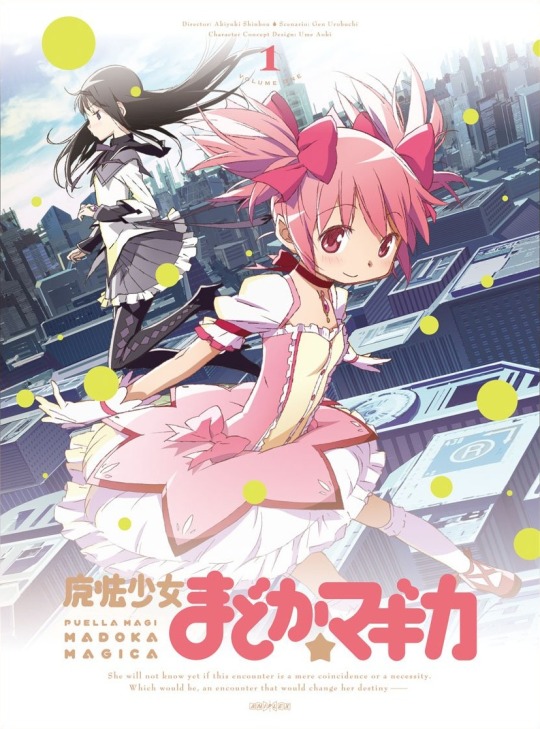
In the same way that everyone knows that Darth Vader is Luke’s father or that a certain noble from the North loses their head, there are some story twists which percolate into the general cultural consciousness due to sheer popularity and end up becoming common knowledge. Puella Magi Madoka Magica is a series which blew up to such popularity in 2011 that you’ve probably seen the characters somewhere before even if you don’t watch a lot of anime. You’ve probably also seen this little guy
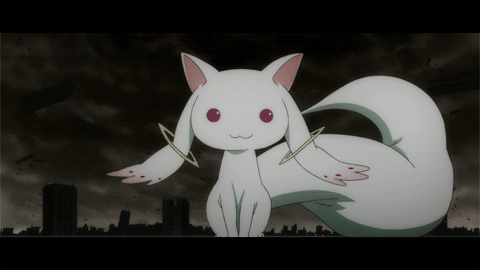
around, often in the context of memes in which either 1) he tries to get people to make a contract or 2) people inflict violence on him and his smug little face never changes.
So while I want to say that Madoka Magica will surprise you when it pulls a left turn into darkness and despair, not only have I just ruined that specific surprise for you but the internet at large more than likely already did that job for me. Not only was this show popular, which translates into a more widespread awareness of its overall tone and some of its twists, other more recent shows have pulled a similar deception. Only last year did we have Made in Abyss, which I haven’t seen yet but which I understand exists for the sole purpose of having cute kids set off on an exciting adventure only to be eaten alive by Uncle Lovecraft’s Happy Fun Time Cave. If you’ve been around the anime niches of the internet or, like me, have a former otaku for a sister then you know from the onset that this show is far more than meets the eye based on reputation alone.
To start with, take a good look at the promotional material for this show, such as the trailer. The production team did their damndest to ensure that from the outside the show would look like the most derivative Magical Girl show ever made, up to and including keeping Gen Urobuchi’s involvement in the production a secret. Gen Urobuchi (aka ButchGen aka The Urobutcher) is a writer who is known for being a bit of a downer, having been involved in projects such as Fate/Zero and Psycho-Pass. He’s very outspoken when it comes to his distaste for heroic archetypes played straight and his tendency to drag his characters through the mud, so his presence as the show’s writer was what you might call a dead giveaway.
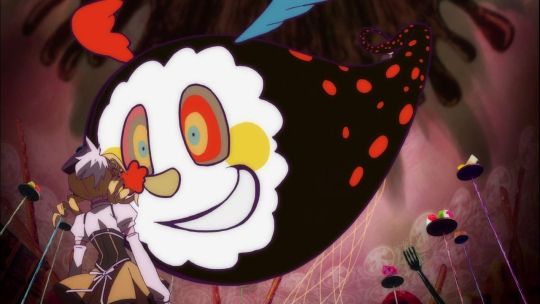
So what happens when a writer like this tackles a genre known for being all about hope, courage, and the power of friendship and love? There are many people who argue that Madoka Magica deconstructs the Magical Girl anime (Magical Girl Warrior subgenre) as codified by Sailor Moon or Cardcaptor Sakura. Some even say it’s the Neon Genesis Evangelion of the Magical Girl genre. As NGE showed us just how psychologically messed up a Giant Robot show would be if populated by actual human beings, Madoka Magica is about how having child combatants fight monsters in an urban environment with no support network does not make a well-adjusted childhood.
The effects of this kind of pressure and isolation on a bunch of adolescents is one of the elements of Madoka Magica, but fighting monsters with magic isn’t the only thing that makes a Magical Girl story. They’re traditionally as much coming-of-age stories as they are stories about definitions of femininity and self-determination. Madoka Magica has the trappings of a MG show: an all-loving protagonist, a dark and aloof rival, a tomboy friend, a non-magical friend, transformation sequences, fighting against the manifestations of dark emotions, and a cute(?) mascot. It’s talking the talk, but at its heart this is not a story about Magical Girl stories in the same way NGE was about Giant Robot anime (that’s what Revolutionary Girl Utena is for). It certainly plays with many common elements of the Magical Girl anime, but at its heart Madoka Magica is about hope, despair, idealism and selfishness. It’s a psychological drama and grand tragedy. It just happens to be wearing a Magical Girl outfit.
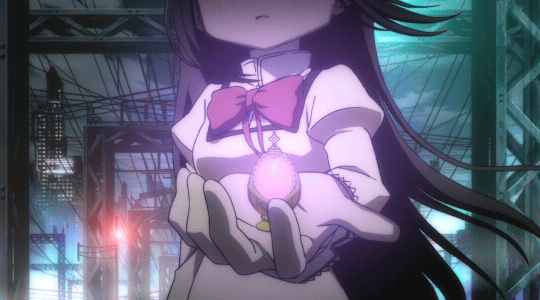
Which is not to say that one is superior to the other, of course. Just set your expectations accordingly if you’re already a Magical Girl fan. If you’re not, well, you might be in luck...
Twelve episodes isn’t a whole lot of time and Madoka Magica does a lot in those twelve episodes, so while I’m willing to spoil the tone of the story discussing the plot itself is a bit trickier. Kaname Madoka is our pink-haired milquetoast protagonist who doesn’t think she’s anything special, and just wants to make friends with everyone. We’re introduced to her via dream sequence, where she witnesses a dark-haired girl fighting against an enemy ravaging the city. A strange white bunny-cat creature asks Madoka to make a contract and become a magical girl, and then she wakes up. It turns out that when not dreaming of plot foreshadowing, Madoka has a pretty good life; a cool mom, a loving dad and good friends. But today it turns out the new transfer student at school - Akemi Homura - is the same girl from her dream. Homura warns Madoka to never change, to stay exactly as she is if she doesn’t want to lose her friends, family, everything she has ever loved. We wouldn’t have much of a story if Madoka never changed, though, so it isn’t long before the bunny-cat creature from the dream crashes into the narrative as well and introduces himself as Kyubey.
Kyubey offers Madoka and her best friend Sayaka an opportunity: make a contract with him and he will grant a single wish, any wish. In return the wisher receives magic powers and must now fight Witches. Not the pointed-hat, broomstick-riding variety, but rather strange, eldritch beings which bring about despair, death and suicide among ordinary humans. It sounds like a good deal: get magic powers and a superhero job on top of a wish? Who wouldn’t want that? But the catch is that this job is for life. If you’re spending all your free time saving the world, you’re not spending time with friends, getting a boyfriend, even just having fun. Is your wish worth dedicating your life to?
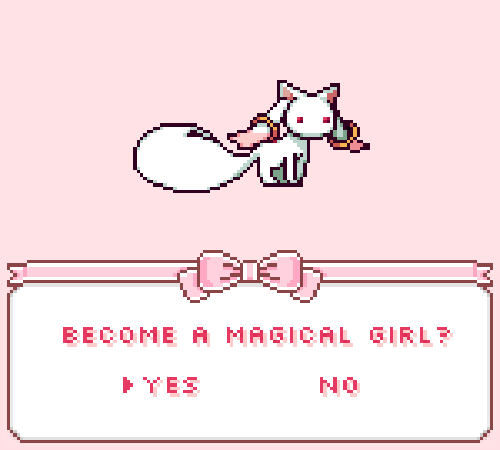
This story has a lot to say about good intentions. Our characters are living pretty good lives, so is there really anything worth giving that up for? Perhaps the wish is better spent on someone who needs it. But, remember, make a wish and you’re essentially fighting on behalf of that wish for the rest of your life. Is what you wish for really what you want, or do you really want some other outcome? Say you wish for a dying friend to heal; do you actually want them healed, or do you really want their eternal gratitude? All the characters in this story have the best intentions, but there’s a gap between intention and execution. If you don’t know what you really want, all the idealism in the world isn’t going to save you from your own regrets.
The phrase “I just wanted what was best” is a damning one. It's key to remember that the characters are adolescent girls, with all the contradictory vulnerability and immovable self-righteousness which comes at that age. It's the age at which ideas of how the world should be collide rudely with how the world actually is, and a person can either deal with it by changing themselves and developing coping mechanisms - healthy or unhealthy - or else break themselves on the impossibility of making their ideals fit with the system. Then again, it might be possible to change the system itself... but that’s a long shot.
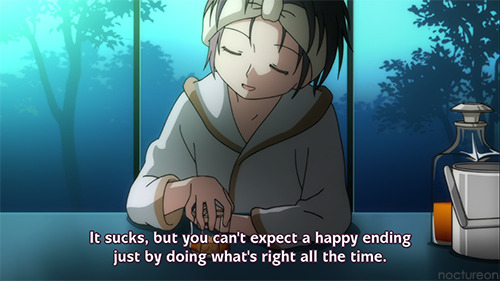
At one point Madoka’s mother gives her a piece of advice: if you see your friend hurting themselves while trying to to the right thing, maybe the best thing to do is to do the wrong thing for them to break them out of their self-destructive cycle. After all, they’re all still young, they’re at an age where recovering from mistakes is supposed to be easier than when you’re an adult. But this advice happens to come at the wrong time, because these kids are stuck in a situation where a mistake can cost one’s life.
As it happens the relationship between Madoka and her mother is one of the highlights in the series. Mom is a career-chasing businesswoman who still takes the time to talk to her daughter, and though she may not be working her dream job she’s living life on her own terms and is obviously an inspiration for Madoka. Her relationship with Madoka plays a surprisingly important role in the story, which is a refreshing change since parents are usually a non-factor or killed off for backstory purposes. The rest of the characters fit much more neatly into standard archetypes. Madoka herself has a big heart and wants everyone to get along, while her much more outgoing friend Sayaka is the go-getter who will take on problems head-first. We’re introduced early on to a much more experienced magical girl named Tomoe Mami, and she ends up taking a sort of big sister mentor role. All three of these girls believe in helping and protecting others, though each has their own take on the best way of doing so. Homura on the other hand is the dark and mysterious loner who for some reason is fixated on Madoka. We feel like she’s an antagonist, but another character who enters the story later turns out to be even more hostile. The red to Sayaka’s idealistic blue, this new magical girl feels like the antithesis to the magical girl ideals we’re used to: selfish, violent and hedonistic.

As elemental as each of these characters is, by the end of the story each one ends up in a very different place than where they started - or else had their starting position shifted altogether. Not everyone is what they seem. Homura’s backstory in particular hits like a truck when it finally arrives and ends up being key to the resolution of the plot. That said, Madoka Magica is not a story that goes in for particularly complex characterization. Its twelve-episode runtime forces a fast buildup and resolution. Friendships and other relationships don’t really have the time to mature on screen, and a lot has to be left to subtext or inference. Each character’s arc takes them where they need to go for the story to progress, and it’s not necessarily a bad thing. Some of these character arcs are desperately tragic tales of misunderstandings and misplaced idealism, but in the end these are still archetypal characters, though perhaps not the archetype you expected. Ultimately, they serve more as conflicting views on the show’s central themes than as the driving force of the story itself. The short length of the show is a weakness, keeping the story from being able to develop the cast as much as would have been ideal.
On the other hand, the show’s compact twelve episode structure is also its strength, and the ‘realism’ of the characters is much less important than what each one represents in the story as a whole. It’s hard to say whether or not Puella Magi Madoka Magica would’ve been able to hit as hard as it does if was any longer. This is a story very much focused on building its plot and keeping a steady pace, layering the tone and atmosphere and absolutely killing it in the aesthetics department. It is a straightforward story when all’s said and done, but it is densely constructed and cohesive. Every element of the show works as part of a whole and builds on the others, the visuals, the cinematography, the music, and even in the way the plot is structured. It’s got no time for cheap fanservice, it makes full use of every moment, and it only gets better on repeat viewings. This isn’t a show that supports casual viewing, and it expects you to be paying as much attention to the way a character is being framed in a shot as to what’s being said (or not said) in the dialogue. This is ultimately a simple story, yes, but it’s dense and constantly being told on multiple layers.
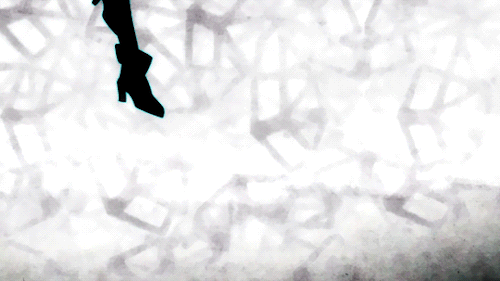
Puella Magi Madoka Magica’s ace in the hole is its mixed-media action scenes. Whenever our characters are fighting a Witch the show pulls a Terry Gilliam and starts doing very strange things with the animation. The medium of the art itself changes, with our cel-animated characters fighting against and among stop-motion objects. Paper cutouts and cotton balls. Lace and embroidery. The effect is unnerving and psychedelic and sometimes overwhelming. It can be difficult to follow the action whenever this happens, but then again these are supposed to be things that aren’t quite in sync with reality, beings which practically run on magic. The fact that these unreal things and spaces are being represented with real-world objects intruding into the animation is a clever touch. It’s an effect that I’ve rarely seen used in anime, and never in an action-heavy context.
(Author’s addendum: I’m aware that director Akiyuki Shinbo’s thing is this mix of visual styles. I do think its usage in Madoka Magica is still notable, if only because it works really well here.)

Even when it’s being more conventional Madoka Magica is visually accomplished. Even though the wide-faced character designs threw me for a loop at first (so wide!) they did eventually grow on me. There’s something about how the eyes look almost penciled-in which keeps them from straying into overly-cutesy territory. The cinematography is likewise superb. Strong, stylized color work drives home tone and emotion. The setting often dwarfs people within vast, empty cityscapes, the background itself being a reflection of the characters’ emotions and the series’ tone. In dialogue-heavy scenes we get momentary flashes of expression and action illustrating what’s happening inside a character’s head, and the framing of characters in a scene tells you everything you need to know about their relationships without saying a word. Whatever else you might think about Madoka Magica, it looks beautiful and tells much of its story visually through color, framing, light and shadow.
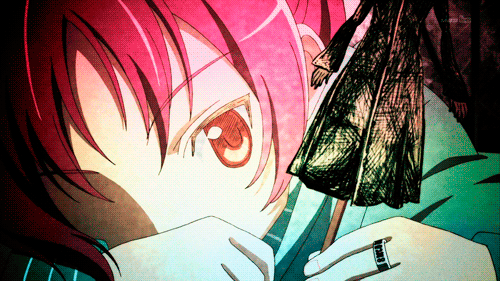
Going further than that, the structure of the plot is beautifully constructed as well. You could divide the story into four arcs of three episodes, each following the development of a different character, or else three arcs of four episodes, each one ending with a new point of no return. The third and tenth episodes mirror each other as well, each one shifting the stakes and giving us new context for everything which came before. The reason why this show shines so much brighter on a rewatch is because things that seemed like inconsequential melodrama or lazy writing the first time around take on a whole new meaning once backstory and motivation are revealed. It’s for this reason that I’m not terribly concerned about revealing Puella Magi Madoka Magica’s swerve into darkness; high stakes and dark subject matter are not the only secrets that this series has got up its sleeve. By the end of the story we’re not only dissecting the intentions and desires of our characters, we’re asking hard questions about why this story had to happen the way it did at all, questions which lead to what might be one of the most satisfying conclusions to an anime I’ve ever seen.
That is perhaps what makes Madoka Magica the show that it is. Though the ultimate shape of the story is straightforward, we journey there through layers of twisting color and twisting plot. Though we have our perspective on the events of the story constantly re-contextualized about once an episode, it’s always building to a conclusion that both feels inevitable and yet less likely the closer we get. And when the end does arrive, it takes everything that has happened so far, every mistake, every hope, every good intention gone wrong and it makes them matter. Though the ending is theoretically open ended, it’s entirely self-contained. It has introduced us to a new world, revealed the lies underlying this world, and has shown us what these characters do about it. It raises questions, and in the end tells us what it’s been saying all along. Few shows, anime or otherwise, use such a cohesive combination of visuals, narrative, and music to deliver a message. Beautiful to look at, beautiful to listen to, and beautiful in how it unfolds.
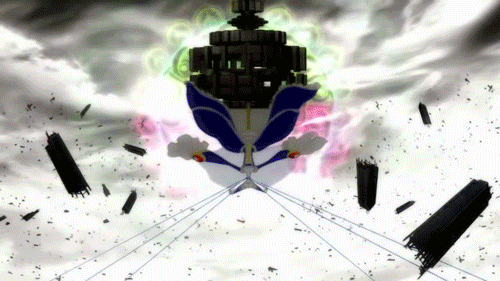
As it turned out, a sequel movie was made anyways. I refuse to provide any comprehensive thoughts on Puella Magi Madoka Magica: Rebellion for now, because doing so runs the risk of being flayed alive by the fandom no matter your take. Suffice it to say that it’s incredibly self-indulgent, visually stunning, and it will make you regret wishing that the ending of the original series could have been happier.
Puella Magi Madoka Magica is beautiful, and you really should watch it.
- Taihus, the wish-granting @raincoastgamer
(And I somehow manage to write all of this without actually discussing the soundtrack. The thing is, I don’t really know how to critique a soundtrack. It’s good, its use of leitmotifs is masterful and actually brought me to tears in episode 8, Magia represents the show’s true face behind the pleasant pink facade, and I’ve still got Sis Puella Magica stuck in my head.)
#puella magi madoka magica#pmmm#madoka magica#review#ramble#anime#anime ramble#anime article#anime review#I wrote a thing#gen urobuchi#akiyuki shinbo#studio shaft#aniplex#ume aoki#yuki kajiura
80 notes
·
View notes
Text
Balance to the Force: An In-Depth Fan Analysis of how Rey is the Sequel Trilogy’s Chosen One
Written by Christian Ang
Beloved by generations of fans, Star Wars was first introduced on screen in 1977, and has since been an iconic piece of cinematic and pop culture history, that has since influenced the genre to come. Yet, as Lucasfilm would later be helmed by a new team after The Walt Disney Company had purchased the company and all subsequent franchises, including Star Wars, new films had been proposed to continue the legacy that came before it. However, the lore of the Star Wars films are coveted by many, and those that had been with the series in its early days, hold many of its elements, including original cuts of the first trilogy dear to them. As such, Lucasfilm and its founder, George Lucas, were vital in shaping and preserving the growing mythos that would later be expanded in books, comics, and animated television shows. One core component of the pantheon of characters that exist is the focus of the films in which the first six movies centralized in telling the tragic story of Anakin Skywalker, a boy destined to influence the galaxy in great and powerful ways. Below is an analysis of all canonical films and television shows that currently exist at the time of writing this essay, and how the future of the films would play out in reintroducing the concept of the Chosen One. While there have been recent books and comics that also elaborates the details in between the on-screen media, not including those from the Expanded Universe banner, these will be otherwise unacknowledged on the basis that both Disney and Lucasfilm had stated that the main canon of the series is primarily kept within the aforementioned films and television programs.
Star Wars tells its narratives in a circular fashion. This is often supported by George Lucas, himself, in which he states that the nature of the prequel and original trilogy functions as a symbolic circle. We begin with the rise and fall of Anakin and then his rise to redemption as Darth Vader. Kathleen Kennedy, president of Lucasfilm, has gone on record with different press junkets to reinforce that the Star Wars films have always been about family dynamics, and Lucas also mentioned, before Disney’s acquisition, that the films have always been about the character of Anakin Skywalker. Through this logic, though Anakin may not exist as a physical character, his spiritual essence is reinvigorated through Rey.
If Lucasfilm is continuing the tradition in maintaining this circle, this can be denoted in the way that The Force Awakens heavily draws its influence on A New Hope. However, in 1999, when The Phantom Menace was released, this was also supposed to be the prequel equivalent of the same film. It is also the same film that introduces the Chosen One concept into the mythos of the films. As a result, it would not be surprising for Lucasfilm to take both films’ concepts and merge them into the first film of the sequel trilogy. On the other hand, it can be argued that when Poe Dameron destroys Starkiller base, it does not necessarily line up with the Circle Theory, as it is Luke and Anakin that have the climactic moment in their respective space battles. This can be a narrative oversight, in which it was more important to emphasize the conflict between Rey and Kylo. Yet, we see Rey have the same natural piloting prowess that Anakin had as a child, with her telling Finn that she had no prior experience in doing so.
The catalyst in which Anakin, Luke, and now Rey embark on their journey usually comes from someone from outside their world and bringing them into the fray of the conflict. When we first meet Anakin as a young boy, it is through meeting Qui-Gon Jinn, Padme, and Obi Wan who are not residing in the planet and takes him along on their journey. This is echoed in A New Hope in which R2-D2 and C-3PO, who were recently on Leia’s ship, encounter Luke and Ben Kenobi, and serves as an expositional tool set Luke on his path. As such, this is the same with Rey, in which her way of living is disrupted upon meeting BB-8 and Finn. Further parallels to Anakin and Luke persist throughout The Force Awakens, in which she encounters the other characters. Maz Kanata asks Han who is this girl, and the rest of the dialogue in the film keeps reiterating the same question: who is Rey? It is an obvious trope in which the mystery of Rey is made known to the audience, and yet there is a distinctive connection, though it is currently unknown how. There is a strong, unspoken bond between her and Han Solo, as well as Leia in the conclusion of the film. If there was a direct familial relation, they would have recognized her. However, if she was the Chosen One, then it would make sense for the original trilogy characters to be drawn to her in a spiritual sense, though they might not understand why.
Rey’s vision further dives into exploring this connection, in which by touching the lightsaber, she sees a cryptic series of events. First, she hears Vader’s breathing as the scene unfolds into the corridor in Bespin in which Luke would subsequently lose his hand, dropping the lightsaber that Rey had just touched. This can be interpreted as the last time the audience had last seen this saber, as well as a connection to her past life as Anakin and the fact that he encountered his former saber once again. Later, the scene continues to shift into showing R2-D2 and what the audience assumes to be Luke in a robe. Though one can deduce that since she doesn’t know what Luke looks like, this could be why Luke’s face is not shown on screen. However, this would not make sense, as we also see the forest that Rey would battle Kylo Ren, and even sees a massive slaughter from the Knights of Ren. This is all before Rey actually meets Kylo Ren in person. Through that logic, one can even further speculate that it was not even Luke under that robe, but rather Anakin before his battle on Mustafar. This is also inconsistent, however, as much of Anakin’s attire is darker tones of black and maroon, as seen in the Clone Wars animated television show, and in both The Attack of the Clones, and The Revenge of the Sith. This can even be delved in further as this may possibly be Rey in the future, for some reason on a lava planet that is meant to be significant. This may also allude to a return to Mustafar in either a flashback, if it was Luke, or in the future if it was Rey. Regardless, in Rogue One, the audience encounters Darth Vader in a large castle-like structure on a lava planet, thus providing plausibility as to why one would see either Luke or Rey at a similar environment. If the films are really about Anakin’s character, then it would not be out of context to revisit this castle if the protagonists believe there is something important hidden within there. Furthermore, in the vision, the voices of both Yoda and Obi Wan (both as a young and old man), can be heard in whispers throughout this sequence. Despite never meeting them, this would only make sense if Rey was channeling this through her past life as Anakin. In effect, both Jedi masters played a huge role in influencing Rey, and the latter being Anakin’s former master.
Throughout the prequel trilogy, Obi Wan wrestles with the question if Anakin really is the Chosen One, to which the Council also can be seen discussing this as well. Qui-Gon, however, is convinced that Anakin will fulfill this prophecy, as he is unusually strong with the Force, and desires to train him before his demise at the end of The Phantom Menace. As a result, this is an obvious reference and parallel to the life of Jesus Christ. Shmi states that Anakin has no father and that she was mysteriously pregnant. Moreover, much like Jesus, there is doubt that Anakin is a messianic figure. In the climax of Revenge of the Sith, Obi Wan tells Anakin of this prophecy and that he was intended to “destroy the Sith, not join them”. This is not necessarily true, as the prophecy is said that the Chosen One would bring balance to the Force. Anakin accomplishes this, in fact, by helping wipe out most of the Jedi Order as they were too powerful over the Dark Side. However, Obi Wan’s claims would later be fulfilled as Vader kills Palpatine and himself, thus ending the reign of the Sith, and thus balancing the Force once more. Years later within The Force Awakens, the only characters that are trained in the Force or are familiar with sensing it when meeting Rey, would be Kylo Ren, Snoke, and Maz Kanata. Maz senses a connection between the former lightsaber of Anakin with Rey, and Kylo also notes to Snoke that she is incredibly powerful in the Force though untrained. Lastly, Snoke senses an “awakening”, which is implied to be Rey. It is not uncommon for young children to be born with a potential connection in using the Force. In fact, this is mentioned in the Rebels animated series in which Stormtroopers are searching for children who may be proficient in the Force, just as Ezra would later be. In effect, Rey’s use of the Force should not alert, let alone worry Kylo or Snoke, as this should be common in the galaxy, unless she is the new Chosen One to bring balance once again to the Force.
Kylo Ren’s journey is made to parallel Ben Solo’s descent into the Dark Side like his grandfather, Anakin, and becomes obsessed with fulfilling his idea of his familial legacy. In fact, Kylo can be interpreted as Rey’s antithesis. In conjunction with Circle Theory and the tendency of the franchise to rely on symbolism, Rey is everything that Kylo desires to be: his grandfather. When trying to extract the map leading to Luke’s location, Rey resists, despite lacking any training, and overwhelms Kylo, only to tell him his fear of not living up to the legacy of Darth Vader. The parallelism that surround them both continue to be riddled throughout the film. Both characters belong to opposing factions, and both have an important connection to Han Solo. In the final battle, Kylo attempts to reclaim his grandfather’s lightsaber, which instead goes to Rey, as she uses the very weapon belonging to his family against him. It is important to note that this saber was easily called upon by Luke, Kylo’s uncle, and the notion that the saber would be easily drawn upon the Force to a girl who he believes to be unrelated to himself would be devastating. Kylo desires to be the Chosen One, while Rey simply is thrust into that role. Rey is ultimately the true successor to Anakin’s legacy, and Kylo is rather a false prophet that believes his own idea of what that legacy means.
Lightsabers are built through a Jedi’s will in union with the Force. Thus, it represents a personal symbol, and source of identification of that respective Jedi. In the Clone Wars and in Rebels, the construction of a lightsaber is explored, and in Rogue One, the Kyber crystals that are used to power the Jedi weapons are bastardized into functioning as the main power source for the Death Star. Throughout the Clone Wars television show, the connection to one’s saber is important, and this is seen in A New Hope in the symbolic “passing of the torch” to Luke as Obi Wan hands over Anakin’s saber. In fact, Anakin makes note of how personal and important this is to him in an episode of the Clone Wars. As stated above, Luke and Rey are both able to call upon the saber with ease, while Kylo, a descendant of Anakin, cannot. Maz even states that the saber was calling upon Rey, and notes the legacy of its former users. If Rey is revealed not to be Luke’s daughter, as that would be a reveal that would not have had paid off as well, and is in fact the new Chosen One, the dramatic connection would be more impactful. Furthermore, Luke already has his own saber, as seen in Return of the Jedi, and would no longer need his father’s, thus giving it to Rey.
Much speculation had risen, in anticipation of the film, that Kylo Ren and Rey were in fact a new iteration of Jacen and Jaina Solo, and are related to the Skywalker family, as seen in the Expanded Universe of books and comics. While the former was in fact revealed to be related to this lineage, Rey’s family is intentionally kept a secret. If it was the intention of the film to preserve the reveal that Rey was somehow blood related, why bother revealing Kylo Ren’s connection so immediately? This can be resolved in application with Circle Theory in which Episode VIII would emulate many of the same elements of both Empire Strikes Back and Attack of the Clones. Within Empire Strikes Back, Vader unveils the truth and tells Luke that he is, in fact, Anakin Skywalker. Though Attack of the Clones does not have a tantamount reveal parallel to this, both Anakin and Luke lose their hands in combat with a Sith Lord. While Kylo is not defined as a Sith Lord, Episode VIII, if it follows a narrative pattern like The Force Awakens and A New Hope, would see Rey facing off against Kylo Ren once more. The parallels between VIII and Empire Strikes Back is further supported as Lando Calrissian is expected to return, just as he was introduced in the latter. Luke also parallels Yoda’s role, in which he is now the exiled Jedi on a remote planet that is intended to train Rey. Yet, what is more important is the further character development that is to be expected in the upcoming film, and the reveal of Rey’s connection is undoubtedly a core component as well, in its plot. Paralleling the middle films in both trilogies that came before it, a single iconic piece of dialogue that overall shaped the importance of the films to come after it in the franchise was built upon the twist that Darth Vader was the fallen Anakin Skywalker. For Kylo Ren as he questions who Rey is to him, Rey would subsequently call him to the Light, just as his grandfather attempted to do the inverse to his uncle many years ago. As Ren resists, he would claim that he intends to accomplish what his grandfather tried to, only for Rey to knowingly say, through the Force, that, in fact, she is the risen Anakin Skywalker.
5 notes
·
View notes